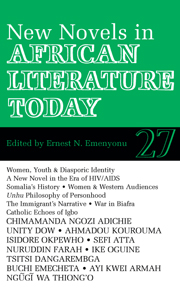Book contents
- Frontmatter
- Contents
- Notes on Contributors
- EDITORIAL ARTICLE: The African Novel in the 21st Century: Sustaining the Gains of the 20th Century
- ARTICLES
- Resurgent Spirits, Catholic Echoes of Igbo & Petals of Purple: The Syncretised World of Chimamanda Ngozi Adichie's Purple Hibiscus
- Ambivalent Inscriptions: Women, Youth & Diasporic Identity in Buchi Emecheta's Later Fiction
- The Interrupted Dance: Racial Memory in Isidore Okpewho's Call Me By My Rightful Name
- The Ivorian Crisis & Ahmadou Kourouma's Posthumous Political Novel Quand on Refuse on dit non
- Ngũgĩ's Wizard of the Crow: Women as the “Voice of the People” & the Western Audience
- The Ankh & Maat: Symbols of Successful Revolution in Ayi Kwei Armah's Osiris Rising
- A New African Youth Novel in the Era of HIV/AIDS: An Analysis of Unity Dow's Far & Beyon'
- The Prison of Nigerian Woman: Female Complicity in Sefi Atta's Everything Good Will Come
- Manufacturing Skin for Somalia's History: Nuruddin Farah's Deep Hurt in Links
- A Zimbabwean Ethic of Humanity: Tsitsi Dangarembga's The Book of Not & the Unhu Philosophy of Personhood
- ‘Coming to America’: Ike Oguine's A Squatter's Tale & the Nigerian/African Immigrant's Narrative
- Chimamanda Ngozi Adichie's Half of a Yellow Sun
- REVIEW
- Index
The Ankh & Maat: Symbols of Successful Revolution in Ayi Kwei Armah's Osiris Rising
from ARTICLES
Published online by Cambridge University Press: 05 April 2013
- Frontmatter
- Contents
- Notes on Contributors
- EDITORIAL ARTICLE: The African Novel in the 21st Century: Sustaining the Gains of the 20th Century
- ARTICLES
- Resurgent Spirits, Catholic Echoes of Igbo & Petals of Purple: The Syncretised World of Chimamanda Ngozi Adichie's Purple Hibiscus
- Ambivalent Inscriptions: Women, Youth & Diasporic Identity in Buchi Emecheta's Later Fiction
- The Interrupted Dance: Racial Memory in Isidore Okpewho's Call Me By My Rightful Name
- The Ivorian Crisis & Ahmadou Kourouma's Posthumous Political Novel Quand on Refuse on dit non
- Ngũgĩ's Wizard of the Crow: Women as the “Voice of the People” & the Western Audience
- The Ankh & Maat: Symbols of Successful Revolution in Ayi Kwei Armah's Osiris Rising
- A New African Youth Novel in the Era of HIV/AIDS: An Analysis of Unity Dow's Far & Beyon'
- The Prison of Nigerian Woman: Female Complicity in Sefi Atta's Everything Good Will Come
- Manufacturing Skin for Somalia's History: Nuruddin Farah's Deep Hurt in Links
- A Zimbabwean Ethic of Humanity: Tsitsi Dangarembga's The Book of Not & the Unhu Philosophy of Personhood
- ‘Coming to America’: Ike Oguine's A Squatter's Tale & the Nigerian/African Immigrant's Narrative
- Chimamanda Ngozi Adichie's Half of a Yellow Sun
- REVIEW
- Index
Summary
In his 1972 book, Rebellion, Revolution and Armed Force, the social scientist, D.E.H. Russell, refers to ‘unsuccessful’ revolution, ‘partially successful’ revolution and ‘successful’ revolution. He argues that the first produces minimal social change, the second a middling degree of social change, and the third, which he feels is the ideal, major social change: ‘Successful revolution is defined as substantial (or fundamental) social change resulting from rebellion’ (58). Bearing this definition in mind, it becomes obvious that much of contemporary Africa is in dire need of successful revolution. Foreign rule, civilian rule and military rule have all failed to bring about positive social change on a continent that is to a large extent rapidly deteriorating in its morals and its economy. Africa is still searching for a means of social regeneration, and this is clearly one of the motivating factors behind the writing of Ayi Kwei Armah's sixth novel, Osiris Rising (OR). Armah believes that the key to social regeneration lies in ancient Egyptian culture – in its uniqueness, its polish, and above all its testimony to African creativity.
With the reputation Armah enjoys as one of Africa's leading novelists, one would have expected this 1995 publication to have provoked a flood of critical response. On the contrary very little has been written on it, and a comment in an article captioned ‘The Meaning of Life’ could explain why.
- Type
- Chapter
- Information
- New Novels in African Literature Today , pp. 65 - 74Publisher: Boydell & BrewerPrint publication year: 2009



